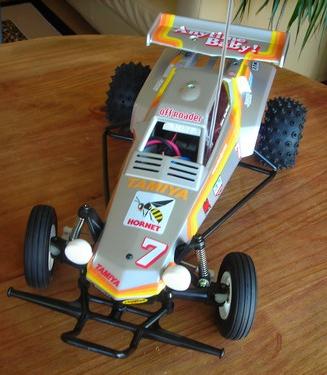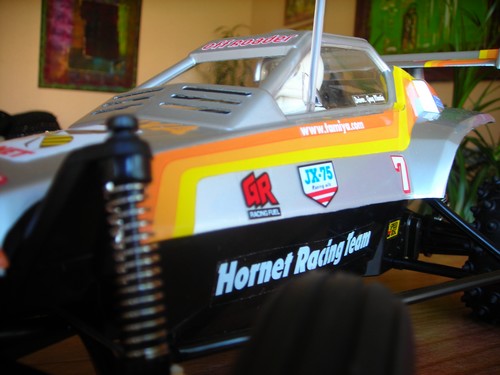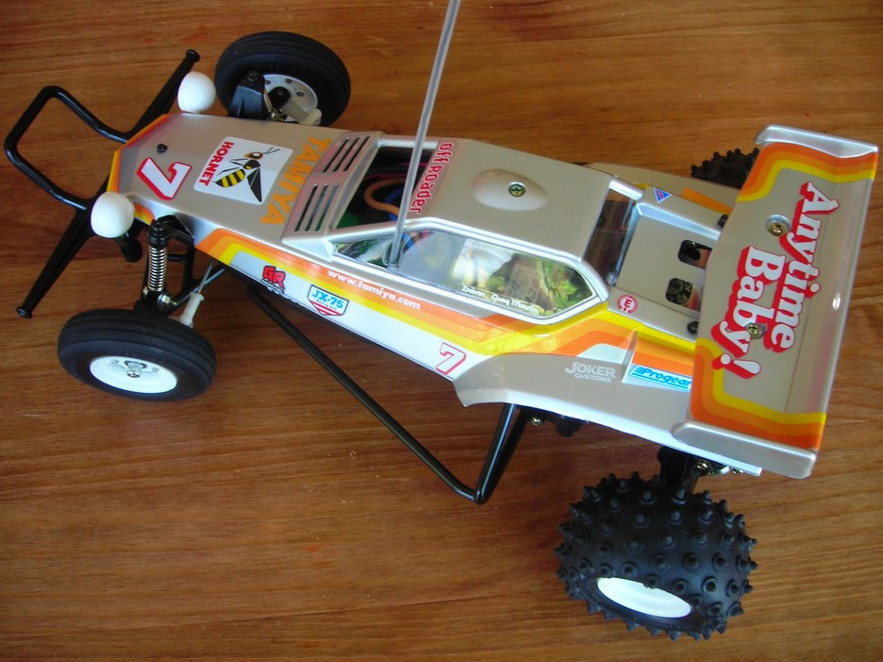The Hornet
The RC family grows with the addition of a new Tamiya model: the re-release of the 1984 iconic model.
This 2 wheel drive buggy in the same category as the famous Grasshopper and The Frog. Its handling is very different compared to my two other models: when the Blackfoot goes straight like a brute with a relative slow speed, the Baja King goes much faster and it is more precise and agile. The Hornet goes pretty fast but with an unpredictable handling. I will directly fit ball bearings all around, but I won't change anything else.
The Hornet family
The Hornet chassis can be found on several other models and many parts can be found on a wider ranger of models (like the gearbox/rear drive train on the Lunch Box and the Midnight Pumpkin).
58043 - The Grasshopper (1984)
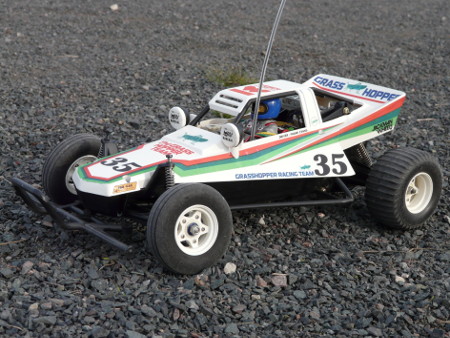
58045 - The Hornet (1984)
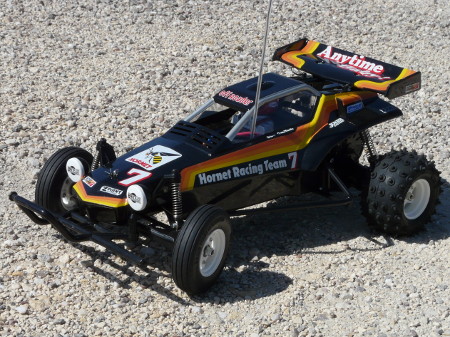
58074 - Grasshopper II (1988)
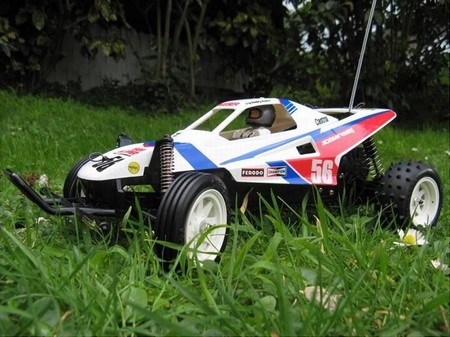
58124 - Super Hornet (1993)
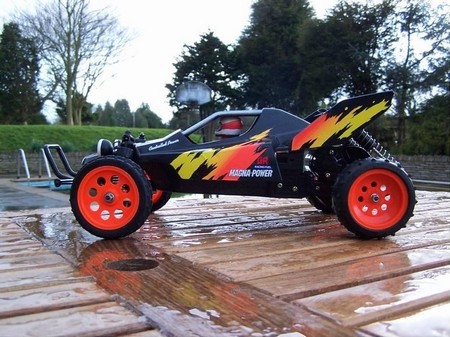
58184 - Fighter Buggy RX (1996)
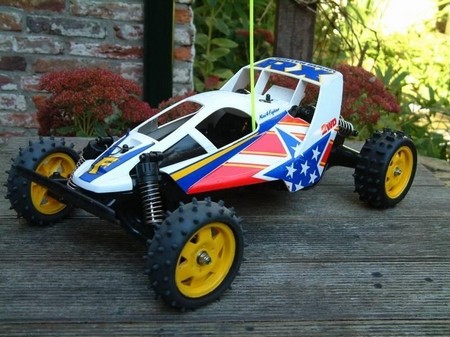
58205 - Madbull (1997)
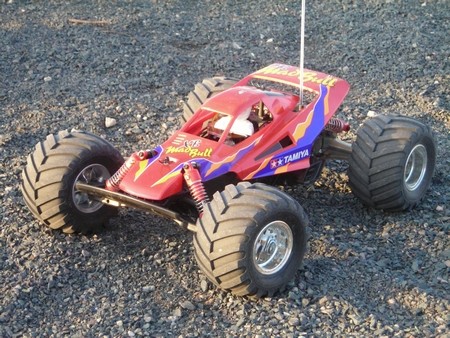
58275 - Mad Fighter (2001)
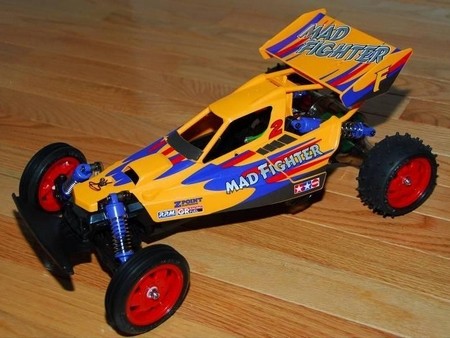
In this model family, Grasshopper I & II are the basic models, the Hornet is an evolution (especially on the suspension and the Mabuchi 540 motor that replaces the 380) and the Super Hornet features every possible option to improve its handling. The chassis remains exactly the same on all these models.
A few years later, Tamiya made changes on the chassis to release new models. The damper fit is different (oriented towards the inner chassis both at front and rear) and the rear drive train does now feature a central pivot axle.
These two main evolutions have a direct and obvious consequence over the chassis handling. Even if it remains strictly oriented to recreational use, the suspension works much better and can correctly deal with any playground surface. The typical bouncy handling of the original chassis can be almost forgotten.
Three models benefited from this improved chassis: the Fighter Buggy RX, the Madbull and the Mad Fighter presented above and on the left. This modified chassis is called a DT-01.
The Hornet bodyshell
Compared to the Baja King, I decided to test the second method: I will cut the body and then paint it. After testing both methods, I find this one better: it is more a convenience matter than practical. Anyway, the difference is not that obvious, and whatever, you will have to perform the two steps in whatever order.
The bodyshell painting was very fast to do thanks to the summer heat of this 2007 april month. I also have to say that the color scheme is monochrome and that masking is only required for windows. To be sure, I let the paint dry all night long.
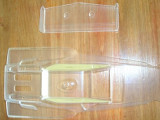
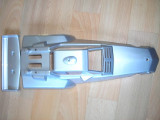
Then, I removed the window masking tape. I chose a different color from the official box art scheme. I am proud of the result with the silver gray I used.
The driver and the lights also need painting (with another paint). The high level of details on the driver requires hours of painting with a very thin brush.
The last steps are to assemble the wing on the bodyshell and to drill the holes for the body mounts.
Assembling the Hornet chassis
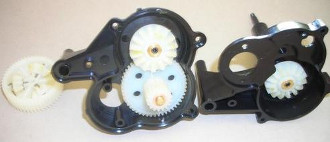
Like on my previous models, I immediately replace every plastic bearing with ball bearings.
The very first step is to assemble the gearbox that will later be fitted to the bathtub chassis. The chassis will then receive all the electronics and the battery pack placed in a longitudinal way (by contrast with my two other models).
The assembly is very easy to perform. However, I paused a long time after fitting the rear drive train to the chassis because the suspension system looked strange. So strange that I first thought I had made a mistake.
In fact, I made no mistake: this strange system compensate the fixed drive train (meaning the rear wheels are not independent). This is a big difference from the Blackfoot and the Baja King that have independent drive trains on their four wheels while on the Hornet, the drive train oscillates on itself.
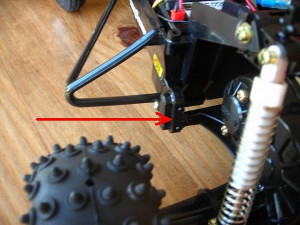
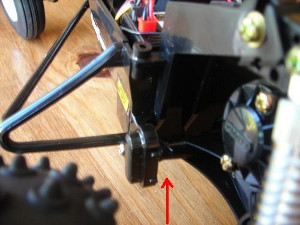
On voit ici pointé par une flèche le travail de bascule du pont arrière à l'intérieur du châssis.
The next assembly steps rise no problem at all as everything is very simple and detailed in the illustrated manual.
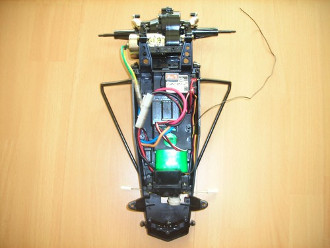
The battery pack needs to be inserted by the underside of the chassis. There isn't much room left to place it. This requires to insert the battery pack with caution and placing its wires carefully because they have to go very close from the steering servo. The rest of the cables have to be tied, but there is plenty of room for that.
As for electronics, they receive plenty of fresh air to remain cool as there is not front window on the bodyshell: the counterparts is that electronics may be spread by mud or dust. If needed, I will try to protect them (balloons should do the job).
One word about wheel assembly: without any doubt, this is the trickiest part of the overall assembly. It can even be considered as pure pain. The rims are made of 3 parts: the rim itself (that inserts into the tire), and 2 lateral parts to be screwed on each side (like hubcaps). Inserting the rim into the tire is the hardest step to perform because you need force to stretch the tire and force to fit it around the rim.
I recommend you start with the front wheels assembly to understand exactly how to process. Because assembling the rear wheels is even more difficult due to to bigger size.
I was amazed how difficult this step is. No doubt a child can't do it whereas the rest of the assembly is very easy. We are used to Tamiya (very) easy steps for assembling the models. Is it because the Hornet is an 1984 re-release? May be at the time it was not possible to make it simpler?
Anyway, my Hornet is now finished to assemble. I'm very happy with the silver grey body paint. I had to change a little bit the sticker layout, especially by sticking some of them directly onto the chassis (white letter on silver grey, I had no choice ![]() ). You decide whether you like it or not: on my side, I have a lot of fun draining battery packs with this model!
). You decide whether you like it or not: on my side, I have a lot of fun draining battery packs with this model!
